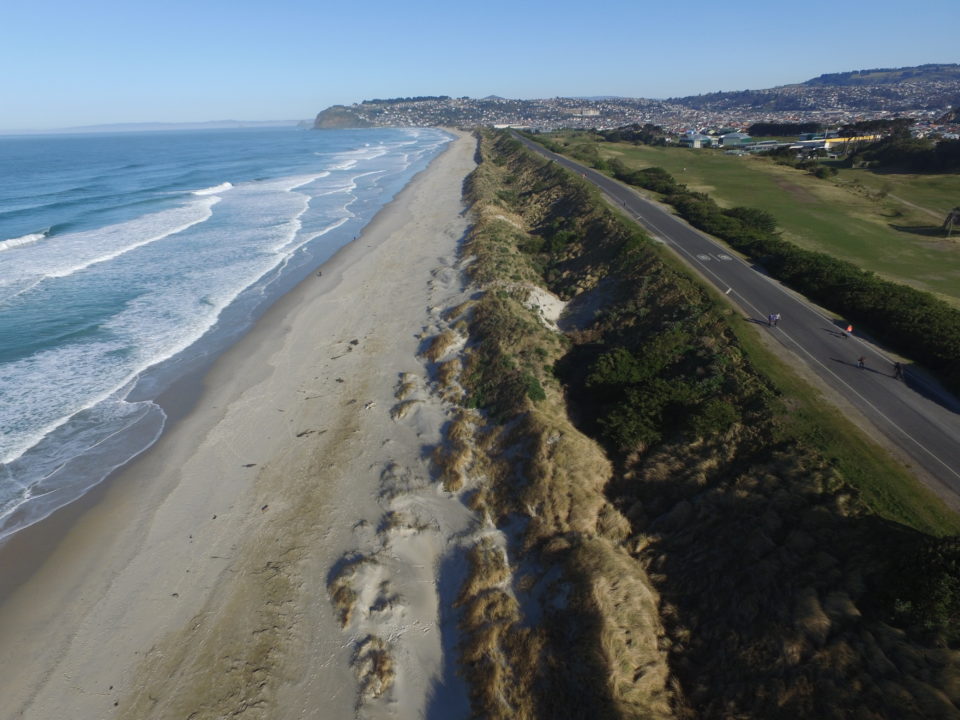Tom Simons-Smith, Dunedin City Council’s, Coastal Specialist and a professional geomorphologist, explains how his council is reaching out to the community before remedial works start on Dunedin’s city coastline.
Dunedin’s St. Clair to St. Kilda coastline is a dynamic frontier between the greater South Dunedin area and the South Pacific Ocean.
Only a narrow strip of infrastructure, sand dunes and greenery separates the sea from the low-lying inland area. This strip of land is shaped and impacted by storms that lower the beach by several metres, attack the seawall with strong winds and waves, and erode the sand dunes.
The erosion undermines infrastructure, reduces public access and amenity value. These issues largely have their origins in the decisions made over a century ago when large areas of the beach and sand dunes were drained to create sports fields, a coastal landfill, the St. Clair Esplanade, and other amenities.
The challenge facing Dunedin is deciding what exactly should be done with this inherited landscape. In recent decades, the management approach at St. Clair and St. Kilda has been reactive and dominated by short-term maintenance of coastal infrastructure and the sand dunes.
This approach has led to more rock being placed on the beach to protect the sea wall, a significant reno-mattress buried in front of the sand dunes, and a 200 metre geotextile sand-filled structure installed to the east of the St. Clair sea wall.
These actions have addressed immediate issues, but have pushed the coastline further seaward and led to infrastructure being more heavily impacted by coastal processes. With rising seas and increasingly frequent coastal storms, we can expect the coastal frontage of St.Clair and St. Kilda to face further challenges.
The challenge
There are many reasons why local authorities slide into a reactive space, particularly when it comes to coastal management. For instance, a lack of resources can constrain our ability to be forward-thinking. Equally, incomplete understandings of coastal processes and ‘climate change’ can make it difficult to make cost-effective short-term actions that transition well into the future.
Proactive coastal management requires an element of risk taking and a strong understanding of what matters most to our communities. What defines coastal management outcomes as ‘good’ is variable and highly dependent on the individual.
This has been one of Dunedin City Council’s (DCC) critical management errors, albeit without them knowing it. A council or any group cannot expect to deliver good coastal management in complex and integrated systems if they lack an understanding of what people truly want.
Compounding these challenges are those that lie inland, in ageing water infrastructure, a high groundwater table and communities with low socioeconomic status.
Overcoming these challenges and avoiding deferring to the next generation requires long-term thinking and a different approach to decision making.
Transitioning to a proactive approach
Many of the obstacles faced by the coastline can be overcome with a long-term plan that considers the processes shaping the whole system along the coast and moves beyond simply responding with temporary fixes.
If we don’t make a start now, we will continue to spend money on reactive maintenance. Money that would be better invested in laying a foundation for a more sustainable coastline. The community needs a vision for the coast that can be incrementally implemented and is affordable and attainable.
It should be a vision shaped with the community that maintains enough of what the community values, and introduces opportunities for new amenities, safe access, and maintains or improves the natural character of this extraordinary coastline.
Coastal management practitioners understand how to take an adaptive approach to long-term coastal planning, but this is not common practice for councils and it can be hard for communities to understand.
The coastal plan must be flexible, avoid the mistakes of the past and create a more resilient coastline predominantly of natural character. This approach allows the council and the community to change course when necessary, but with a clear understanding of why and how change will be managed.
We are fortunate for having a community that is passionate about our coast and wants to see it thrive. Much of the land along the coast is owned by the DCC, so we have fewer constraints and more opportunities than others.
The DCC is investing in an open and transparent programme of engagement with a diverse range of people who value the coast or might be affected by any future plans.
Founded on the principles of the International Association of Public Participation, and guided by Ministry for Environment’s coastal hazard and climate change guidance the engagement programme starts in March 2020.
This engagement will help create the vision and priorities for the coast. After that, there will be opportunities for our community to consider and give feedback on different options for achieving the vision for the coast over time.
The goal is that the council will be able to approve the resulting plan within the next 12 months.



